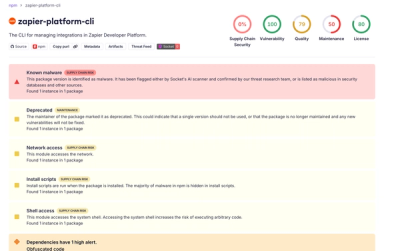
Research
/Security News
Shai Hulud Strikes Again (v2)
Another wave of Shai-Hulud campaign hits npm.
@aoberoi/passport-slack
Advanced tools
Passport strategy for authenticating with the Slack OAuth 2.0 API. This package is helpful to implement Add to Slack and Sign In with Slack for your applications.
$ npm install --save passport @aoberoi/passport-slack
Before using this package, you must create a Slack App. You will be issued a Client ID and Client Secret, which need to be provided to the strategy. You will also need to configure a Redirect URL which matches a route in your node HTTP server.
The Slack strategy authenticates users using their Slack account and OAuth 2.0 access tokens. The
Client ID and Client Secret obtained when creating your Slack App are supplied as options when
creating the strategy. The strategy also requires a verify callback, which receives an access
token for the user, the scopes for which the token was authorized, the team in which the user
authorized your application, and optionally an authorization for a Bot User, an Incoming
Webhook, and the user's profile. The verify callback must call done providing the value you
want to assign to req.user in authenticated requests.
passport.use(new SlackStrategy({
clientID: SLACK_CLIENT_ID,
clientSecret: SLACK_CLIENT_SECRET,
}, (accessToken, scopes, team, { bot, incomingWebhook }, { user: userProfile , team: teamProfile }, done) => {
// Create your desired user model and then call `done()`
User.findOrCreate({ slackId: userProfile.id }, function (err, user) {
return done(err, user);
});
}));
Use passport.authenticate(), specifying the 'slack' strategy, to authenticate requests.
For example, as route middleware in an Express application:
// Visiting this route when not already authenticated with slack will redirect the user to slack.com
// and ask the user to authorize your application for the default scope (`identity.basic`).
app.get('/auth/slack', passport.authenticate('slack'));
// The user returns to the your site after the authorization above, and if it was successful
// the next route handler runs, otherwise the user is redirected to chosen failureRedirect.
app.get('/auth/slack/callback',
passport.authenticate('slack', { failureRedirect: '/login' }),
function(req, res) {
// Successful authentication, redirect home.
res.redirect('/');
});
Instead of the default scope (identity.basic - the least privileged scope for Sign In with Slack),
you can specify your own as options for passport.authenticate().
// Sign In with Slack with multiple scopes for increased authorization. The user and team profiles
// in the verify callback will now have much more information
app.get('/auth/slack', passport.authenticate('slack', {
scope: ['identity.basic', 'identity.email', 'identity.team', 'identity.avatar']
}));
// Add to Slack with many services. The extra argument in the verify callback will now contain
// authorization data for the Bot User and Incoming Webhook.
app.get('/auth/slack', passport.authenticate('slack', {
scope: ['incoming-webhook', 'commands', 'bot']
}));
If your application is already aware of a Slack Team ID that you intend the user to authenticate in, you can specify this ahead of time and save the user from having to select from all Slack Teams they may already be signed into.
app.get('/auth/slack', passport.authenticate('slack', {
team: SLACK_TEAM_ID,
}));
See the example directory for a simple Sign in With Slack server.
TODO
The existing module is a great start on adapting Slack workflows for OAuth. On closer look, I realized that the way Slack does OAuth is a little different from most providers. For example, Slack uses OAuth for Slack App installation, which is more than just authentication. I saw an opportunity to improve the developer ergonomics around making a library that aligns better with those Slack-specific use cases. Here are some of the key differences:
scope and team are options at "authorization-time", rather than when you instantiate the
Strategy.verify callback's arguments are designed for the response you receive from Slack's
oauth.access Web API method. the useless refreshToken is removed, and data about additional
service authorization (like Incoming Webhooks, Slack Commands, etc) are provided.SlackStrategy).FAQs
Slack authentication strategy for Passport
The npm package @aoberoi/passport-slack receives a total of 2,008 weekly downloads. As such, @aoberoi/passport-slack popularity was classified as popular.
We found that @aoberoi/passport-slack demonstrated a not healthy version release cadence and project activity because the last version was released a year ago. It has 1 open source maintainer collaborating on the project.
Did you know?

Socket for GitHub automatically highlights issues in each pull request and monitors the health of all your open source dependencies. Discover the contents of your packages and block harmful activity before you install or update your dependencies.

Research
/Security News
Another wave of Shai-Hulud campaign hits npm.

Product
Add real-time Socket webhook events to your workflows to automatically receive software supply chain alert changes in real time.

Security News
ENISA has become a CVE Program Root, giving the EU a central authority for coordinating vulnerability reporting, disclosure, and cross-border response.